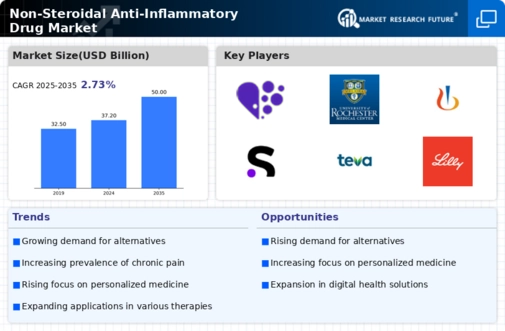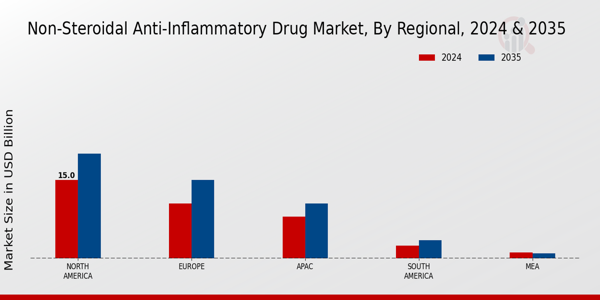Market Trends and Forecasts
The Global Non-Steroidal Anti-Inflammatory Drug Market Industry is characterized by various trends and forecasts that indicate its future trajectory. The market is projected to reach a value of 50 USD Billion by 2035, reflecting a steady growth pattern driven by factors such as increasing demand for pain relief and advancements in drug formulations. The anticipated CAGR of 2.73% from 2025 to 2035 suggests a stable market environment, where ongoing research and development efforts will likely introduce new products and treatment options. This dynamic landscape presents opportunities for stakeholders to engage in innovative practices and meet the evolving needs of patients.
Regulatory Support for NSAID Use
Regulatory bodies are increasingly recognizing the importance of NSAIDs in pain management, which is positively influencing the Global Non-Steroidal Anti-Inflammatory Drug Market Industry. Guidelines and recommendations from health authorities support the use of NSAIDs for various conditions, thereby encouraging their prescription and use. This regulatory backing not only enhances the credibility of NSAIDs but also promotes research and development in this area. As a result, the market is expected to thrive, with projections indicating a market value of 37.2 USD Billion in 2024. This supportive environment is likely to foster innovation and expand the range of NSAID products available to consumers.
Advancements in Drug Formulations
Innovations in drug formulations are playing a crucial role in shaping the Global Non-Steroidal Anti-Inflammatory Drug Market Industry. The development of novel NSAID formulations, including extended-release and combination therapies, enhances efficacy and patient compliance. These advancements allow for more tailored treatment options, addressing specific patient needs and minimizing side effects. For example, the introduction of topical NSAIDs has provided alternatives for patients who may experience gastrointestinal issues with oral medications. This trend is expected to sustain market growth, contributing to a projected CAGR of 2.73% from 2025 to 2035 as new formulations continue to emerge.
Increased Self-Medication Practices
The trend of self-medication is becoming increasingly prevalent, significantly impacting the Global Non-Steroidal Anti-Inflammatory Drug Market Industry. Patients are more frequently opting for over-the-counter NSAIDs to manage mild to moderate pain without the need for a prescription. This shift is driven by the desire for immediate relief and convenience, particularly in regions with limited access to healthcare services. As a result, the market is likely to see a surge in demand for OTC NSAIDs, further solidifying its position within the broader pharmaceutical landscape. This trend aligns with the projected growth trajectory of the market, reinforcing its relevance in contemporary healthcare.
Growing Awareness of Pain Management
There is a notable increase in awareness regarding pain management strategies among both healthcare professionals and patients, which is positively influencing the Global Non-Steroidal Anti-Inflammatory Drug Market Industry. Educational initiatives and campaigns are helping to inform patients about the benefits and risks associated with NSAIDs, leading to more informed decisions regarding their use. This heightened awareness is likely to drive demand, as patients seek effective treatments for their ailments. As a result, the market is anticipated to grow, with an expected value of 50 USD Billion by 2035, reflecting the ongoing commitment to improving pain management practices.
Rising Prevalence of Chronic Pain Conditions
The Global Non-Steroidal Anti-Inflammatory Drug Market Industry is experiencing growth due to the increasing prevalence of chronic pain conditions such as arthritis, back pain, and migraines. As populations age, the incidence of these conditions rises, leading to greater demand for effective pain management solutions. For instance, arthritis affects millions globally, prompting healthcare providers to prescribe NSAIDs as a primary treatment option. This trend is expected to contribute to the market's expansion, with projections indicating a market value of 37.2 USD Billion in 2024. Consequently, the need for NSAIDs is likely to remain robust as healthcare systems adapt to these demographic shifts.























